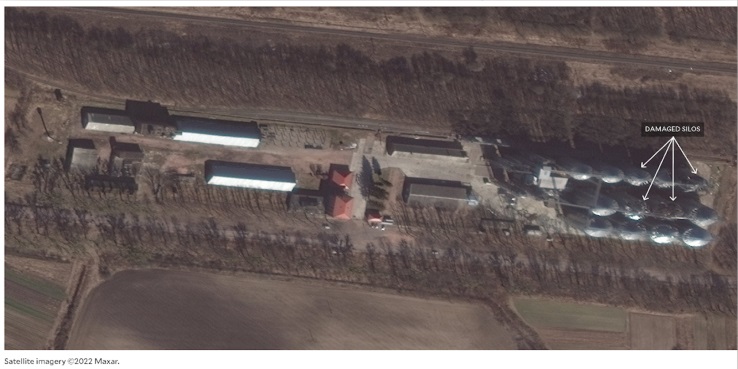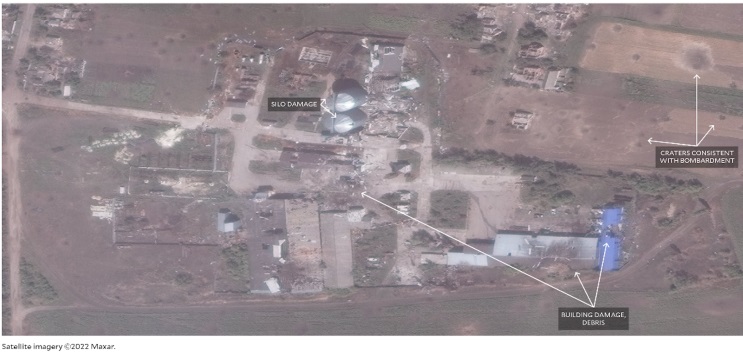Featured Galleries USUBC COLLECTION OF OVER 160 UKRAINE HISTORIC NEWS PHOTOGRAPHS 1918-1997
 Holodomor Posters
Holodomor Posters

Ukraine Crop Storage Sites Impacted by War
Report - Grain Silos & Elevators - Yale University
 Yale Report: Approximately 1 in 6 Ukrainian Crop Storage Sites Impacted by War
Yale Report: Approximately 1 in 6 Ukrainian Crop Storage Sites Impacted by War
Yale School of Public Health
New Haven, CT, Thu, Sep 15, 2022

Damaged silo complex:
Porttransbud (Ovruch Branch Rise) in Zhytomyr Oblast. There are dark markings on the tops of at least six of the facility’s silos, with the greatest apparent damage to the silo in the second row, second from the right/east. Visible damage sustained by silos as of 2022-02-27.
Photo by Image © 2022, Maxar Technologies.

Damaged small-scale grain storage operation:
Safety SFH in Donetsk Oblast on 2022-08-01. Extensive damage is observable throughout the facility and nearby houses. Impact cratering can be seen in an around the facility.
Photo by Image © 2022, Maxar Technologies.
NOTE: Conflict Observatory: A central hub to capture, analyze & make available evidence of Russian perpetuated war crimes & other atrocities in Ukraine. Click on the following link to read the entire, detailed Ukraine's Crop Storage Infrastructure: Post-Invasion Impact Assessment: https://hub.conflictobservatory.org/portal/apps/sites/#/home/pages/grain-1
One of every six (15.73%) Ukrainian crop storage facilities, such as grain silos and elevators, has been damaged, destroyed, or controlled by Russia and its aligned forces since its invasion began on February 24, according to a new report released today by the Yale School of Public Health’s (YSPH) Humanitarian Research Lab(HRL), in collaboration with the U.S. Department of Energy’s Oak Ridge National Laboratory (ORNL).
This represents approximately 14.57% of Ukraine’s total crop storage capacity in tonnage. Analysts identified at least 75 destroyed or damaged storage facilities among the 344 locations visible in satellite imagery collected after Russia’s invasion began. The analysis was undertaken as part of the Conflict Observatory program, which is funded through the U.S. Department of State.
“Russia’s destruction and occupation of Ukraine’s crop storage capacity may deepen an unfolding food security catastrophe for some of the world’s most vulnerable people,” stated Kaveh Khoshnood, associate professor of epidemiology at YSPH and faculty director of the HRL.
“If Ukraine’s farmers don’t have adequate storage, there is a high chance that they may not plant winter wheat and other upcoming crops, which will reduce the available supply of grain for years to come.”
Ukraine had an estimated 58 million metric tons of crop storage capacity available across more than 1,300 storage facilities before the war started. According to the study, at least 3 million tons have been damaged during the war and more than 6 million tons of storage were controlled by Russia and its aligned forces (including 820,000 damaged tons) as of July 2022.
Eighty percent of these damaged and destroyed facilities are located near rail lines and seaports. Of the 75 known damaged or destroyed facilities, 41 are located in three oblasts: Mykolayiv, Zaporizhzhya, and Donetsk. An oblast is an administrative division or region in Ukraine.
“Russia’s destruction and occupation of Ukraine’s crop storage capacity may deepen an unfolding food security catastrophe for some of the world’s most vulnerable people.”
- Associate Professor Kaveh Khoshnood
“Whether indiscriminate or intentional, targeting of crops and crop storage infrastructure can constitute a war crime and a crime against humanity in some cases,” said Nathaniel A. Raymond, executive director of the HRL.
“This report is overwhelming evidence that Ukraine’s farms, silos, grain bins, and elevators have been hit over and over with artillery shells, bombs, and missiles since Russia first attacked Ukraine more than six months ago.”
The current study employed a unique methodology to complete the analysis. An area of interest comprising the nearly 700 storage facilities currently in Ukraine’s control and most likely affected by conflict from ground forces was identified.
Nearly 350 of those locations were imaged (within the past approximately two months) and compared to archival satellite imagery of the location from before the war.
A dataset of these facilities’ locations was provided to the analysts from a 2019 Ukrainian website known as the “Elevatorist” which contains certified crop facilities locations and was taken offline when Russia attacked.
Analysts with the Oak Ridge National Laboratory, in collaboration with HRL, created a custom-built object detection machine learning model that identified facilities not included in the Elevatorist dataset.
UT-Battelle manages ORNL for the Department of Energy’s Office of Science, the single largest supporter of basic research in the physical sciences in the United States. The Office of Science is working to address some of the most pressing challenges of our time. For more information, please visit energy.gov/science.
Submitted by Colin Poitras on September 15, 2022
Conflict Observatory: A central hub to capture, analyze & make available evidence of Russian perpetuated war crimes & other atrocities in Ukraine.
Click on the following link to read the entire, detailed Ukraine's Crop Storage Infrastructure: Post-Invasion Impact Assessment:
https://hub.conflictobservatory.org/portal/apps/sites/#/home/pages/grain-1
Featured in this article:
Kaveh Khoshnood, PhD, MPH
Associate Professor of Epidemiology (Microbial Diseases); Track Director, Critical Topics, Executive MPH; Faculty Director, InnovateHealth Yale; Program Co-Director, Global Health Ethics Program, Yale Institute for Global Health; Track Director, Critical Topics in Public Health, Online Executive MPH Program
Nathaniel Raymond
Lecturer in Epidemiology (Microbial Diseases)
NOTE: Thanks to Yale Graduate George Chopivsky, a long-time supporter and member of USUBC for sending this article.











